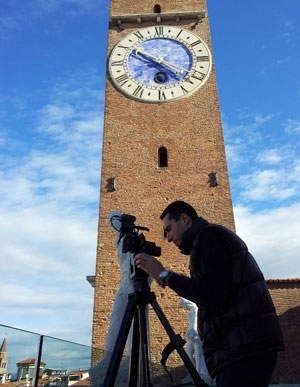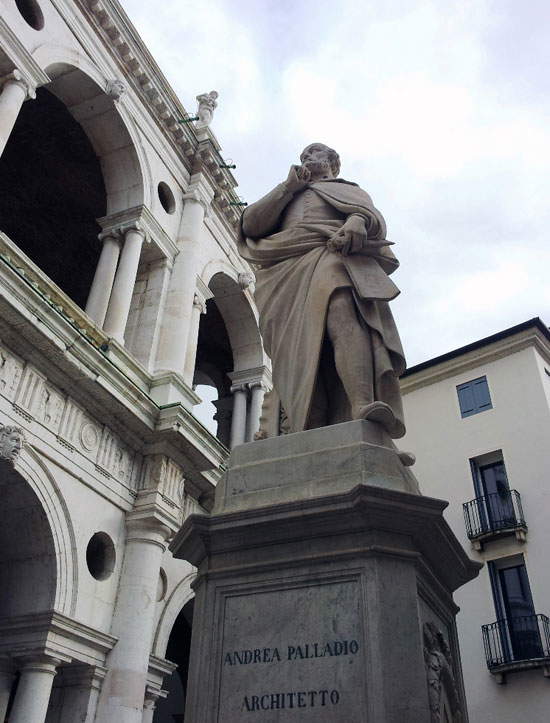For those like me who are always on the lookout for cities of art, and architecture is the main driver of interest, they will surely find in Vicenza light for their eyes. Well, so says UNESCO, which has included it in the World Heritage Site precisely because of its architecture, mainly attributable to the genius of Andrea Palladio, who found fertile ground in the city to give free rein to his classical-Renaissance architecture. If the Basilica (called precisely Palladian) is the universal symbol of the architect (and it is no coincidence that in the small square adjacent to him stands a statue of him), there are many buildings in the city that bear his unmistakable signature.
 |
| Fabrizio with Vicenza’s Torre Bissara, also known as the Torre di Piazza, in the background. |
Palladio was commissioned by the Accademia Olimpica to erect a theater, and the architect, before his death, managed to deliver the design, which was followed in the construction stages by his pupil Vincenzo Scamozzi (the same man who a few years later would design the theater of Sabbioneta, which in many respects is similar to the Vicenza model). What is so special about this theater that goes beyond its beauty and proportion? Suffice it to say that at the time it was built (1585) it was not in use to build permanent theaters: the last ones dated back to the Roman era, in the Middle Ages theaters were temporary outdoor structures, so none had been built for a few centuries.
 |
| The Olympic Theater in Vicenza |
The Teatro Olimpico was the first stable theater to be built after those of Roman times and was the first theater in Europe to have a roof: this is the main feature that identifies it as a model theater. The entire interior structure is made of wood, covered in stucco (with a marble effect), and both the stepped conformation of the cavea and the stage wall are an obvious reference to the Roman theater. The other peculiar feature is the fixed scenography (designed by Scamozzi), which in the small space available gives the perspective illusion of depth, achieved by tilting the stage plane toward the vanishing point and gradually lowering the height and proportion of the elements depicting the city of Thebes. In fact, it reproduces the setting of Sophocles’ Oedipus the King, the theater’s inaugural performance, which was later to be removed but fortunately for us remains as a testimony and model of one of the most beautiful (if not the most beautiful) theatrical architecture and scenography of all time.
In this article of mine I have dwelt mainly on aspects concerning Palladian architecture in Vicenza, but the city offers much more, we tell you extensively about it in the video episode of Ready to Go. Watch it at your leisure and then try to answer the following questions. Until next time!
Question 1: What is the square tower that flanks the Basilica called?
Question 2: What are the people of Vicenza nicknamed?
Question 3: Who was Antonio Pigafetta?
Trivia of the episode: On Mount Berico stands the Shrine of the Virgin Mary, who appeared announcing that Vicenza would be spared from the plague of 1426.
 |
| Vicenza, Palazzo Braschi |
 |
| Andrea Palladio’s statue near the Basilica |
 |
| Entrance to the Olympic Theater in Vicenza |
Warning: the translation into English of the original Italian article was created using automatic tools. We undertake to review all articles, but we do not guarantee the total absence of inaccuracies in the translation due to the program. You can find the original by clicking on the ITA button. If you find any mistake,please contact us.